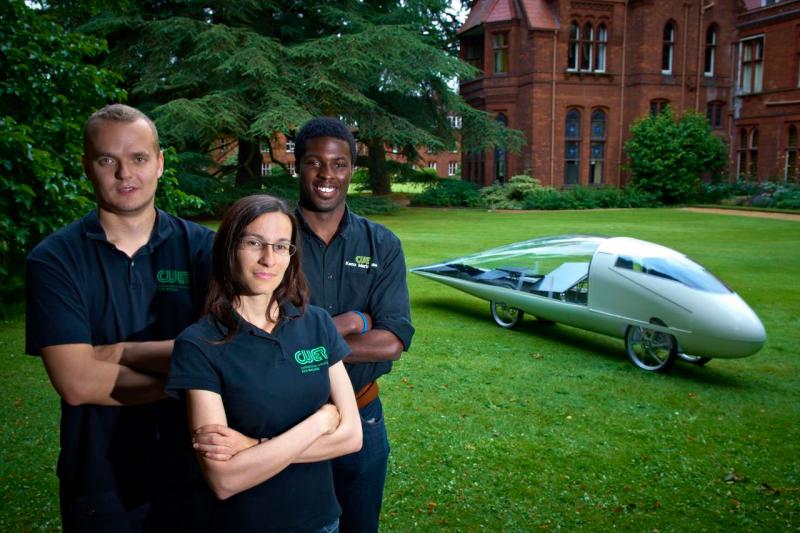Built by undergraduates working for their exams, with funds raised by the students themselves, Cambridge’s solar car is the only British entry into the World Solar Challenge. Despite the odds, however, its radical design could still secure victory.
Built by undergraduates working for their exams, with funds raised by the students themselves, Cambridge’s solar car is the only British entry into the World Solar Challenge. Despite the odds, however, its radical design could still secure victory.
Put simply, our car looks like nothing else in the competition, and that might just give us the edge we need.
Keno Mario-Ghae
After months of planning, design, building and testing, Britain’s only entry into the World Solar Challenge – a 3,000km solar-powered race across Australia – is heading out to the other side of the world.
Created by students at the University of Cambridge, the car, which has been named “Resolution” by its creators, will be transported to Australia on Tuesday. Once there, it will undergo intense examination and further testing before the Darwin to Adelaide race begins on 6 October.
No British team has ever won the competition in its 26-year history. A victory this time would be a triumph of enterprise and ingenuity against the odds. Unlike the most successful of their competitors, who receive funding to build their cars up front, the Cambridge team have to raise the money themselves from scratch. They also have to fit the construction around exams and holiday jobs which, in some cases, are funding their own trips to Australia to compete.
Despite the challenge, however, the team are confident that Resolution’s radically different design has given them a chance. The car, which runs on roughly the same power as a hairdryer, overcomes the traditional trade-off between maximising its power and still having an aerodynamic design by separating the two.
Solar panels are attached to aft-tracking plates across its body, and programmed to follow the movement of the sun across the sky. In most solar cars, the panels are fixed to the vehicle’s surface, which compromises its shape. The use of mobile panels has enabled the team to make Resolution far more aerodynamic than the traditional “table-top” design of most of their competitors.
The result is a vehicle that can move at an astonishing rate. In tests, the car has exceeded 70 miles per hour with a predicted top speed of 87 miles per hour. That bodes well for a competition where the fastest average speed ever recorded by a winner was just under 63mph.
“Put simply, our car looks like nothing else in the competition, and that might just give us the edge we need,” Keno Mario-Ghae, team manager for Cambridge University Eco-Racing, based at the University’s Department of Engineering, said.
“There is still work to do, but we’re at the stage where the devil is in the detail. We’re looking at getting little things to run a bit more smoothly, or with a bit less power. We reckon that we can still squeeze out about 200 watts more in power consumption with a bit of effort.”

The main reason for sending the car to Australia now – weeks before the race itself begins – is the intense preparation period that it will have to pass through on arrival. The car first goes into quarantine, possibly for just five days, but potentially for much longer.
Once released, the vehicle enters a new period of testing. Safety plans have to be submitted, driver turnaround times perfected, and the car undergoes test drives at different speeds. In particular, the team will need to assess how its systems are coping with the heat. Temperatures on the route could reach into the high 30s, which will be gruelling not just for the car, but the student drivers, who will be undertaking four hour stints inside the cramped cockpit.
“It’s basically like Formula One,” Mario-Ghae observed. “Everything we submit gets reviewed and checked to make sure that it complies with the rules. The systems are assessed one by one. Even the drivers have to be weighed in.”
The cost of building the car comes to almost £500,000, but at no stage during it construction period has the team possessed anything resembling that amount of money. Instead, they have had to put it together using corporate sponsorship, donations, a “Name-On-Car” scheme, and crowdfunding through the website Kickstarter.
The net result is that, unlike many of their competitors, there are few spare components. That will make for a tense race because, although the car can potentially reach speeds that will challenge for a place on the winners’ podium, it could also fail if its key parts stop working.
“The margins are tight and and for us something failing could take us from challenging for a winning position to being absolutely nowhere,” Mario-Ghae said. “You just have to pray that everything will work. The race is going to be a massive effort, but if we can get everything right, we genuinely believe that we can win. We’re doing everything that we can to make this happen.”
Further information about Cambridge University Eco-Racing, and how you can support the British team, can be found at https://www.cuer.co.uk/
For more information about this story, please contact Tom Kirk, Tel: 01223 332300, thomas.kirk@admin.cam.ac.uk
This work is licensed under a Creative Commons Licence. If you use this content on your site please link back to this page.





